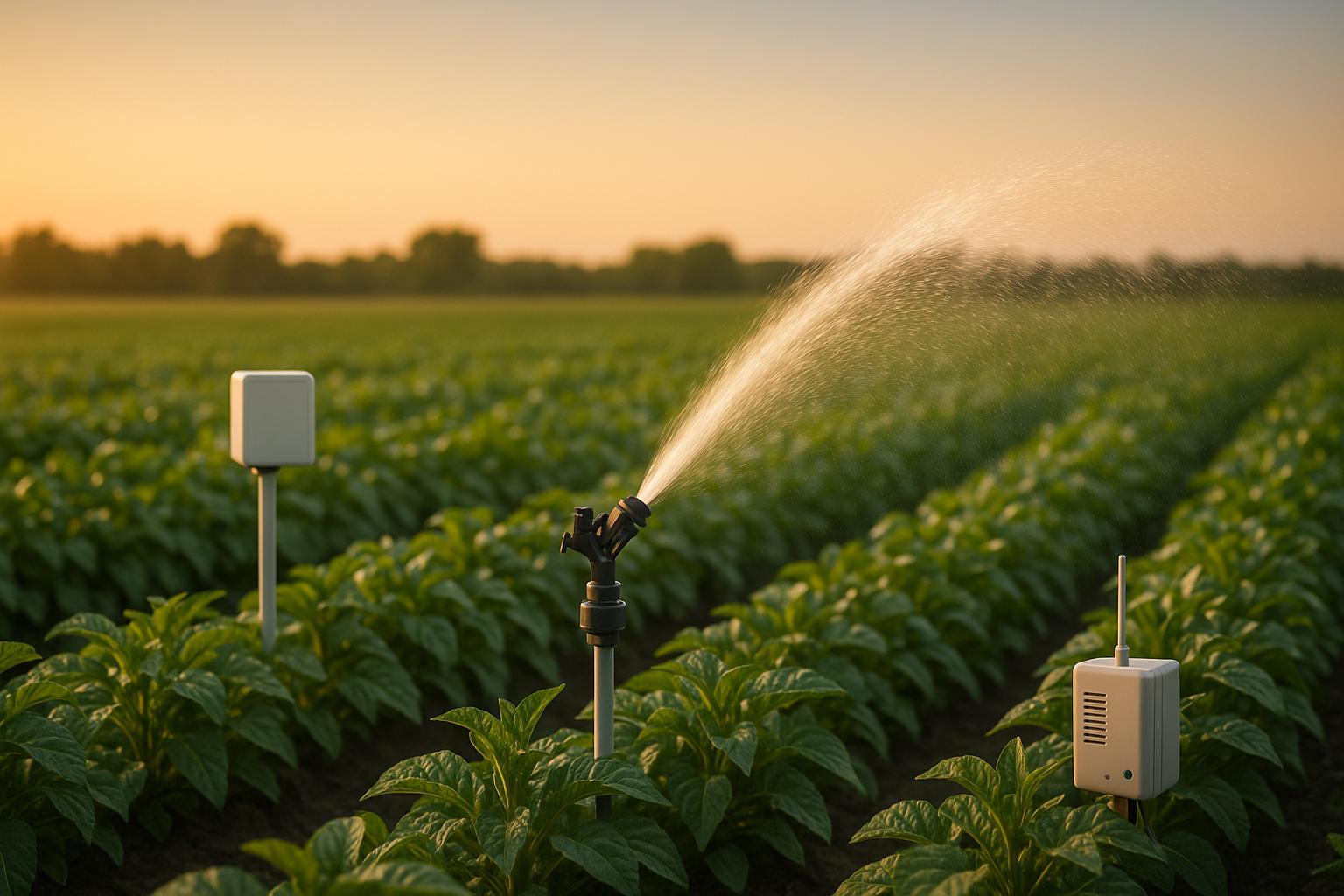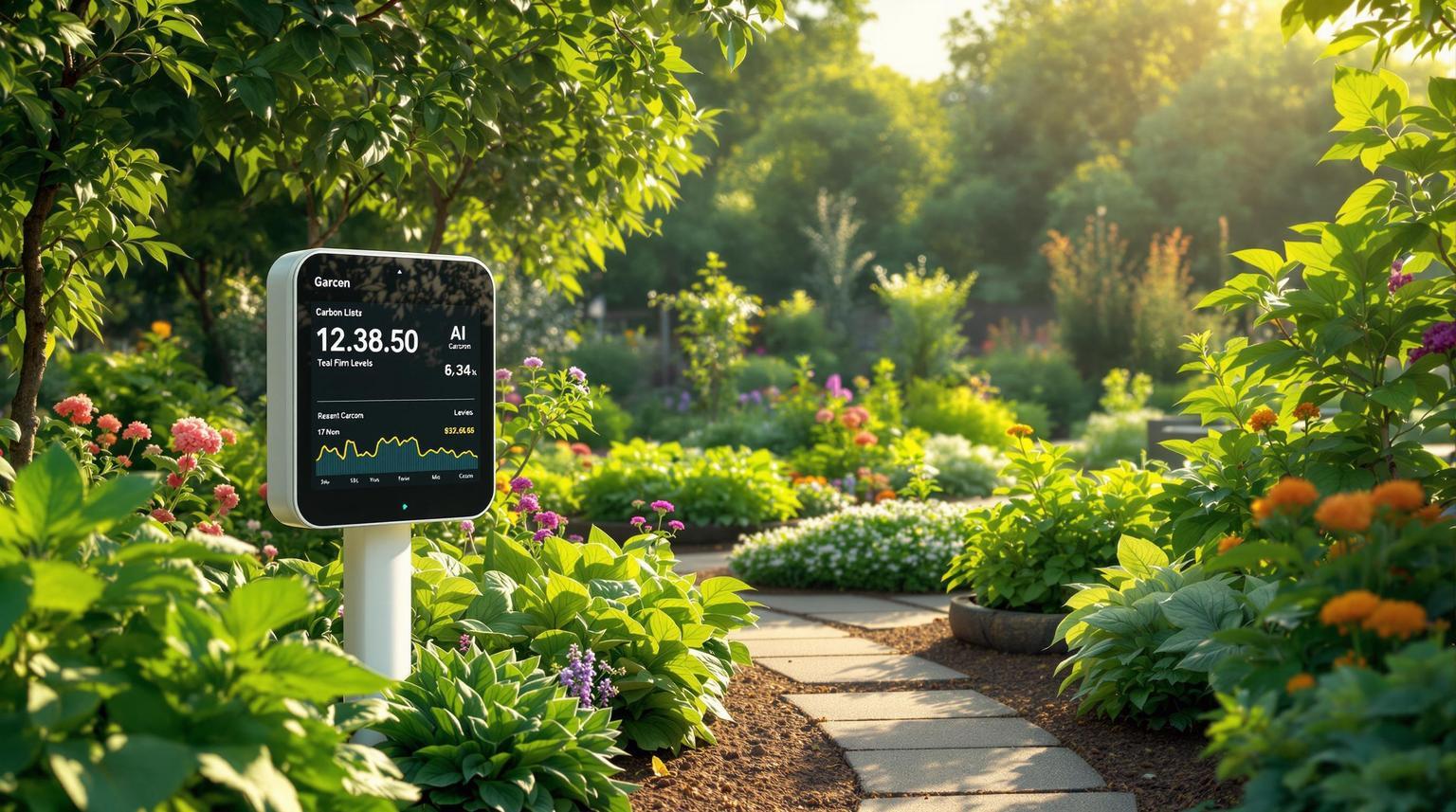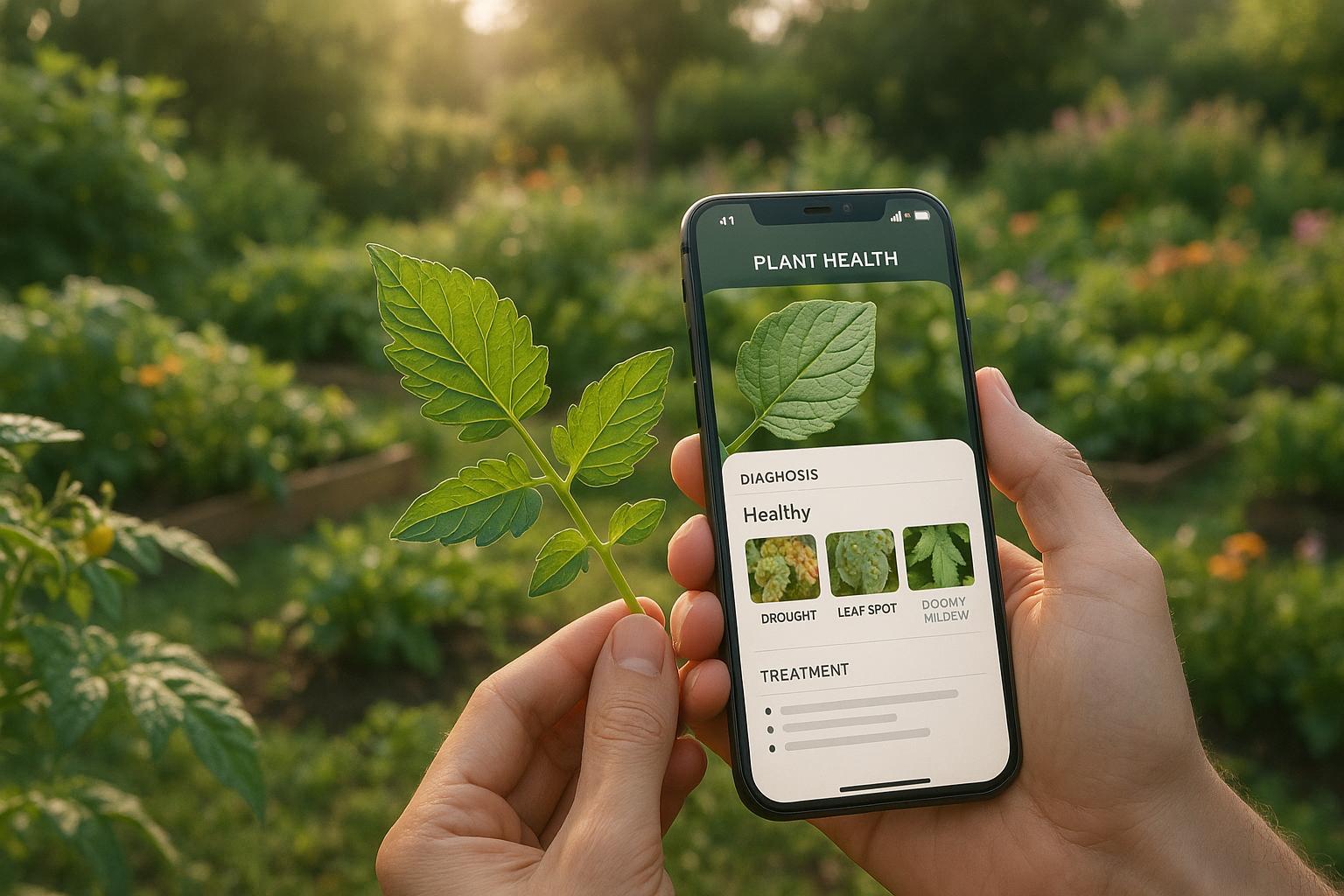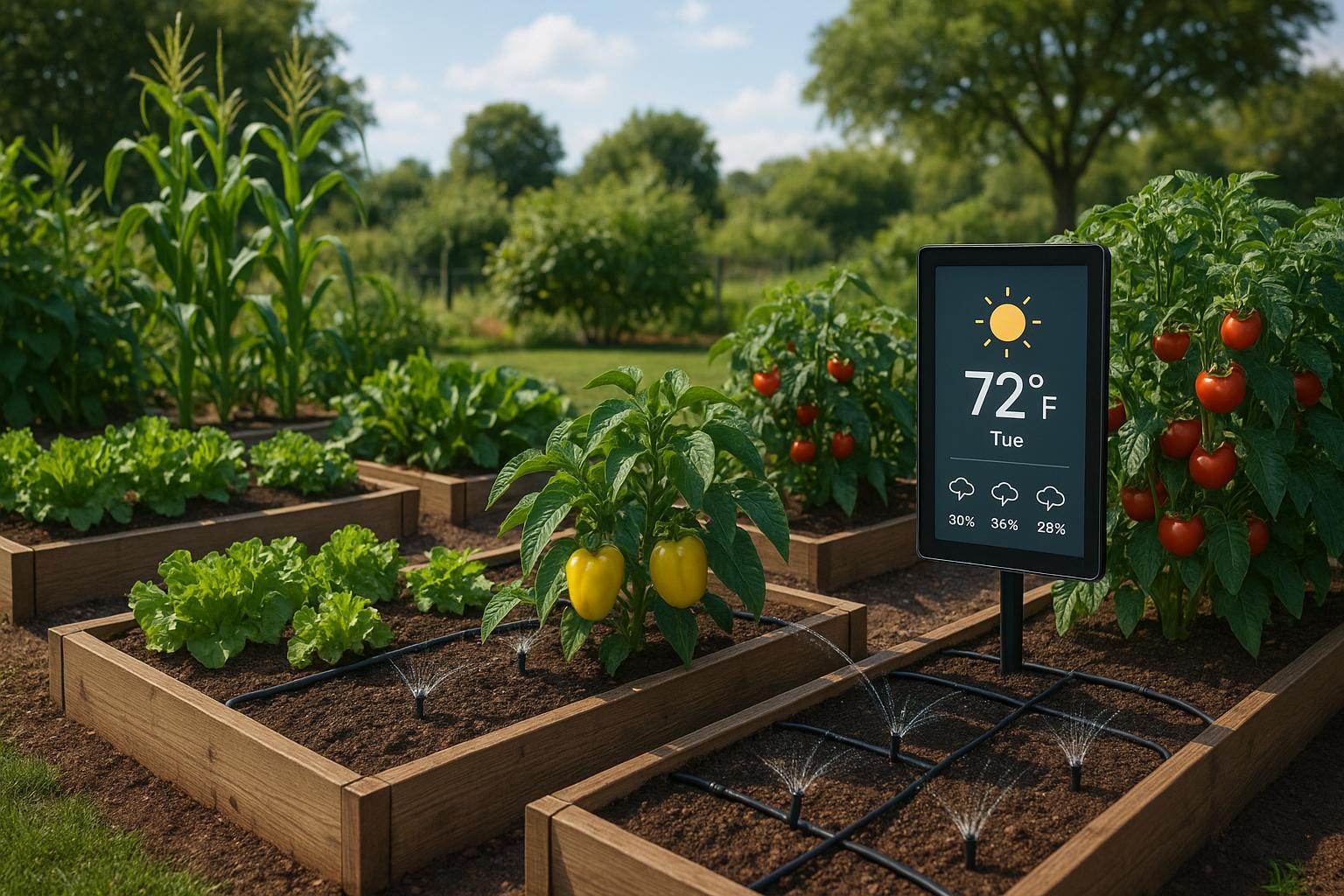How AI Soil Sensors Monitor Moisture and Nutrients

AI soil sensors are transforming gardening and farming by providing real-time insights into soil moisture, temperature, and nutrient levels. These sensors combine advanced hardware and AI-powered software to optimize irrigation, detect nutrient deficiencies early, and improve crop yields by 20–30%. They also help save water - cutting usage by up to 25% - and reduce environmental impact.
Key Benefits:
- Boost Efficiency: Reduce water use by up to 50% and operating costs by 31% per acre.
- Early Problem Detection: Spot nutrient deficiencies or diseases before they become visible.
- Remote Monitoring: Manage soil conditions from anywhere via mobile apps or dashboards.
- Custom Recommendations: AI-generated irrigation and fertilization plans tailored to your soil.
Key Challenges:
- Cost: Systems range from $50 to over $500, with annual maintenance costs of $15–$70.
- Technical Setup: Requires calibration, maintenance, and some tech know-how.
- Data Privacy Concerns: Farmers may worry about how their data is used.
AI soil sensors are most effective for larger gardens or farms aiming to save resources and increase productivity. Proper setup and regular calibration are essential for accurate readings and actionable insights.
Smart Soil Sensors - How Tiny Tech is Revolutionizing Crop Yields and Farming Efficiency

Main Parts of AI Soil Sensors
AI soil sensors combine advanced hardware and intelligent software to monitor soil conditions with precision. These systems work together to track key factors like soil moisture, temperature, pH levels, and nutrients, offering valuable insights for effective soil management.
Hardware Components
The hardware in AI soil sensors plays a crucial role in gathering accurate data about soil conditions, which is then processed by the software for actionable insights.
- Moisture and Temperature Sensors: These sensors measure water content and soil temperature at various depths. Time Domain Reflectometry (TDR) sensors are often preferred for their accuracy in measuring volumetric water content, though they are more expensive compared to capacitance sensors [1].
- Nutrient and pH Sensors: These detect the presence of key nutrients like nitrogen, phosphorus, and potassium while also measuring soil acidity or alkalinity. Electrical conductivity sensors further assess salt levels and overall soil fertility.
- Microcontrollers: Acting as the "brain" of the system, microcontrollers process raw data from the sensors and perform initial filtering before transmitting it to a central system.
- Communication Modules: These enable wireless data transmission. Options like Wi-Fi and Bluetooth are suitable for nearby connections, while LoRaWAN or cellular networks are ideal for remote locations.
- Power Sources: To ensure continuous operation, many systems use a combination of rechargeable batteries and solar panels. Some rely solely on battery power for functionality.
Together, these hardware components form the backbone of AI soil sensors, enabling the software to interpret raw data effectively.
Software and AI Features
The software component transforms the hardware’s raw measurements into meaningful insights and actionable recommendations tailored to specific locations.
- Machine Learning Algorithms: These algorithms analyze historical data, weather patterns, and crop performance to develop predictive models. For instance, they can identify trends in soil moisture changes under certain weather conditions and adjust irrigation suggestions accordingly [3].
- Predictive Analytics: By examining data trends, AI can forecast potential issues like pest infestations, nutrient deficiencies, or disease outbreaks. It also determines optimal planting and harvesting times [5].
- Decision Support Systems: These systems offer recommendations customized to specific environments. For example, irrigation schedules may vary between regions, even if moisture readings are similar, due to differences in climate [5].
- Cloud-Based Data Processing: This centralizes information from sensors across large areas, allowing users to monitor all soil conditions from a single dashboard [5].
- Real-Time Optimization: AI systems adjust recommendations dynamically based on current conditions. For example, they can modulate irrigation to prevent waterlogging or salt buildup and suggest fertilization plans that minimize environmental impact [4].
A practical example of these capabilities can be seen in Edge Impulse’s use of an Arduino equipped with sensors to optimize water usage, improving resource efficiency [5].
How AI Sensors Track Moisture and Nutrients
AI soil sensors are revolutionizing agriculture by continuously collecting and analyzing data to provide real-time insights. These systems don't just gather numbers - they offer targeted, actionable guidance based on the unique needs of each farm or garden. Together, the hardware and software create a fully integrated AI soil sensor ecosystem.
Data Collection and Analysis
The process starts with sensors working in unison to monitor various aspects of soil health. Once the sensors capture raw data, microcontrollers step in to preprocess and filter the information. This refined data is then transmitted wirelessly using standard communication protocols.
From there, AI algorithms take over, using techniques like regression, classification, clustering, time series analysis, and deep learning to analyze the data. These advanced methods enable the system to process huge volumes of information in just seconds. For instance, Stenon's FarmLab is capable of analyzing over 4,500 data points in a matter of moments [1][7].
What sets AI sensors apart is their ability to interpret data in context. They don’t simply report raw figures but consider variables like environmental conditions, crop needs, and historical trends to generate meaningful insights [1]. This means they can detect subtle changes in soil health that might indicate nutrient deficiencies or the early stages of a disease outbreak.
Once the data is processed, it feeds into AI systems that generate precise recommendations tailored to the specific conditions of the soil.
AI-Generated Recommendations
AI systems transform raw sensor data into detailed recommendations, offering customized solutions for each farm or garden. For example, if the sensors detect low moisture levels, the system calculates exact water requirements based on soil type, weather forecasts, and plant needs.
The results can be game-changing. AI-powered systems can reduce water usage by up to 50% and pesticide consumption by as much as 60% [12]. Additionally, farms using AI-driven methods report a 40% reduction in environmental impact [12] and lower operating costs by as much as 31% per acre for major crops [11].
"For my whole life as a farmer, any data I got about nitrogen, which is something you need in the highest quantity, was gathered by taking a soil sample, sending it out, and waiting a few weeks for the results. By which point it was usually too late to do anything…To have it in real time, it changes everything."
- Jim Ward, Sweetgreen Grower [8]
AI doesn’t just analyze current conditions - it predicts future needs. For instance, in 2024, Texas A&M AgriLife Research used AI to forecast the ideal time to prepare a cotton crop for harvest. The system advised early preparation, but when the farmer delayed due to rain, it resulted in a loss of quality and roughly $70 per acre in potential profit [10].
The system can even recommend micronutrient-specific interventions by analyzing soil data alongside weather patterns and crop growth stages. These insights consider both current soil conditions and historical performance data to ensure optimal results [9].
What’s more, these recommendations can integrate with smart farming technologies, enabling automated actions for maximum efficiency.
Smart Technology Connections
Modern AI soil sensors don’t just collect data - they integrate seamlessly with mobile apps and smart controllers to create robust farm management systems. This connectivity allows farmers to monitor soil conditions remotely and respond promptly, even when not on-site [1].
The integration goes beyond monitoring. Smart irrigation systems, for example, combine sensor data with weather forecasts to adjust watering schedules automatically [13]. By analyzing moisture levels and upcoming weather, these systems prevent both under-watering and over-watering.
Key features of these technologies include compatibility with various sensor types, mobile app integration, advanced data analytics, reliable connectivity, customizable alerts, long battery life, and straightforward calibration options [13]. Wireless Sensor Networks (WSNs) play a crucial role by collecting comprehensive environmental data, which is vital for precision farming [6].
"Precision agriculture transcends merely adopting new technologies; it establishes a more precise and sophisticated farm management system."
- Professor Pierre C. Robert [6]
Smart technology also enables GPS-enabled variable rate applications, allowing farmers to apply water, fertilizers, and other inputs exactly where they’re needed. This precision-driven approach is turning agriculture into a science-based practice, significantly boosting productivity [12].
The adoption of these technologies is growing rapidly. In 2020, the global agricultural robot market was valued at $4.9 billion, and it’s expected to reach $11.9 billion by 2026 [6]. Given that agriculture accounts for 85% of global water use [6], the efficiency gains from integrating smart sensors have far-reaching economic and environmental benefits.
Next, explore how you can apply these insights to your own garden or farm.
sbb-itb-4d6a8dd
🚀 Ready to Reinvent Your Garden?
Join thousands of homeowners who have transformed their gardens using our AI design tool. Upload one photo to explore endless possibilities.
Get your AI garden designs →How to Use AI Soil Sensors Properly
Getting the most out of AI soil sensors requires thoughtful planning and consistent care. Proper placement, setup, and regular maintenance are essential for accurate readings, which can lead to healthier plants and improved yields.
Where to Place and Install Sensors
The effectiveness of soil sensors relies heavily on their placement. Factors like sensor type, soil composition, crop type, and irrigation method all play a role in determining the ideal location [17]. For garden beds and field crops, position sensors within crop rows at root level, steering clear of areas where heavy machinery operates [17]. Typically, sensors should be placed 4–6 inches deep, but this can vary depending on the plant. Shallow-rooted vegetables need sensors closer to the surface, while deeper-rooted crops like tomatoes benefit from deeper placements. For plants with extensive root systems, using multiple sensors at varying depths provides a more complete picture of soil conditions [16].
Soil type is another critical consideration. Sensors should ideally be placed in areas that represent the dominant soil type of your field [17]. In gardens with mixed soils - such as clay, sand, and loam - monitoring each type separately may be necessary. In fields with diverse soil conditions, focus on areas that reflect average soil and crop growth patterns [16]. Avoid placing sensors in spots with extreme conditions, such as overly vigorous growth, poor drainage, or irregular soil depths [16]. Additionally, keep sensors away from structures, paved surfaces, or other obstacles that could interfere with readings [16].
For container gardening, use one sensor per container, ensuring it reaches the root zone [16]. If you’re using drip irrigation, position the sensor near the dripper to capture accurate moisture levels [16]. Mark sensor locations with flags to prevent accidental damage from field equipment [15].
Once installed correctly, the next step is to calibrate and maintain your sensors to ensure long-term accuracy.
Setup and Maintenance
Accurate readings start with proper calibration and setup. Most AI soil sensors connect wirelessly to monitoring systems, but some may require manual adjustments during the initial setup.
Begin by calibrating your sensor using two key reference points: dry soil that crumbles easily and fully saturated soil or water [14]. These benchmarks help the sensor translate raw data into meaningful moisture percentages. Regular recalibration, ideally every three months, helps counteract environmental changes [14]. Additionally, perform a full inspection and recalibration annually [14].
Routine maintenance is also crucial. Clean sensors with a soft brush to remove dirt and check for signs of rust or corrosion. If needed, gently remove buildup using fine-grit sandpaper [14]. Protect sensors from harsh weather by housing them in weatherproof enclosures designed to withstand extreme temperatures, humidity, and rain [1]. Establishing a consistent maintenance schedule will help ensure the sensors remain reliable over time [1].
With properly calibrated and maintained sensors, you can confidently analyze data to make smarter gardening decisions.
Reading and Using Sensor Data
Interpreting sensor data is essential for fine-tuning your gardening practices. Most AI soil sensors provide real-time and historical moisture data through mobile apps or web dashboards. Instead of focusing on single readings, pay attention to trends. For instance, a steady decline in moisture over several days usually indicates normal water use, while a sharp drop could point to irrigation problems or sudden weather changes.
Some advanced sensors also measure nutrient levels, but moisture data remains the cornerstone for managing irrigation. To ensure data accuracy, check that cables are shielded and grounded to prevent static interference [14].
Review historical data to uncover patterns in your garden’s moisture levels, especially in relation to plant growth stages and weather conditions. Setting alerts for critical moisture thresholds can help you respond promptly without overreacting to minor changes. Over time, you may find that fine-tuning sensor placement based on specific plant needs or environmental factors leads to even better results [14].
Pros and Cons of AI Soil Sensors
AI soil sensors offer a modern approach to garden management, bringing a mix of benefits and challenges. Knowing these can help you decide if this technology aligns with your gardening needs and budget.
Benefits of AI Soil Sensors
One of the standout perks of AI soil sensors is their ability to improve efficiency. By providing precise soil data, these sensors help optimize water and fertilizer use, reducing water consumption by up to 25% and increasing yields by 20–30% [1][2].
They also excel at spotting problems early, such as nutrient deficiencies or diseases, allowing for quick action [1].
For gardeners managing multiple areas or those with busy schedules, remote monitoring is a game-changer. With sensors placed in various locations, you can check soil conditions from anywhere via the internet, ensuring your plants are well cared for even when you're not around.
Another major advantage is the time and labor saved. These systems can automatically monitor soil conditions and even activate irrigation systems, cutting down the daily workload involved in garden maintenance.
Drawbacks and Challenges
However, AI soil sensors aren’t without their downsides.
The initial cost can be steep for many gardeners. While basic soil moisture sensors are available for under $50, mid-range options with more features typically cost between $50 and $150. High-end systems can go upwards of $500, with annual maintenance costs ranging from $15 to $70 per sensor [18][22].
Their technical complexity is another hurdle. Setting up these systems and integrating them with existing garden tools can be tricky and often requires some technical know-how [19]. Users also need to learn how to interpret the data collected through wireless or software interfaces.
Keeping sensors accurate involves regular calibration and inspections. Environmental factors can impact their performance, meaning occasional cleaning, weatherproofing, and part replacements may be necessary.
There are also concerns about data privacy and security. As highlighted in a Government Accountability Office report:
"Farmers often do not trust the ways farm data are being collected and managed; thus, terms and conditions regarding data use should be simple, transparent, and accountable." [21]
Lastly, these systems may struggle with adaptability. For gardeners dealing with varied growing conditions, AI models might not always provide clear or reliable recommendations. This "black box" nature of decision-making can leave users questioning the system’s conclusions [20].
Pros vs. Cons Comparison Table
Here's a quick overview of the benefits and challenges:
| Advantages | Disadvantages |
|---|---|
| Reduces water use by up to 25% | Initial costs: $50–$500+ |
| Boosts yields by 20–30% | Requires technical knowledge |
| Enables remote monitoring 24/7 | Needs regular maintenance and calibration |
| Detects issues early | Maintenance costs: $15–$70 annually |
| Saves time and labor | Potential data privacy concerns |
| Optimizes water and fertilizer use | Limited adaptability in diverse conditions |
| Useful for remote locations | Complex integration with existing tools |
| Reduces manual labor by up to 60% | "Black box" decision-making can be unclear |
Whether or not AI soil sensors are worth the investment depends on your gardening scale, comfort with technology, and goals. For larger gardens or those aiming for efficiency, the benefits often outweigh the challenges. On the other hand, smaller-scale gardeners or those who prefer hands-on methods might find traditional approaches more practical and affordable.
Conclusion
AI soil sensors are reshaping modern gardening by offering precise insights that streamline maintenance and improve outcomes. These advanced tools go beyond simple data collection, delivering in-depth analysis and tailored recommendations that make managing your garden smarter and more efficient.
The impact is clear: water usage has been reduced by up to 50%, operating costs have dropped by 31% per acre, and input waste has decreased by 30% [12][11][23]. These numbers highlight the transformative potential of this technology.
Sarah Schinckel of John Deere emphasizes this shift:
"AI is a key tool that powers many precision technologies that farmers are using in their fields and in their offices." [24]
Beyond efficiency, these systems allow for remote monitoring and early disease detection, cutting down on manual labor. For gardeners with packed schedules or those overseeing multiple plots, AI sensors can take over repetitive tasks, offering convenience and peace of mind.
However, success relies on proper setup, regular calibration, and thoughtful data interpretation. While these steps require effort, the long-term rewards - especially for larger gardens or commercial operations - are hard to ignore. A well-implemented system can truly redefine gardening practices.
Brendan Collins, co-founder and CEO of Avalo, captures the essence of this technology:
"What AI is offering farmers is a way to use fewer inputs in a more explainable system that guarantees them more profit at the end of the day." [24]
Whether your goal is to conserve resources, boost plant health, or simply make your gardening routine more efficient, AI soil sensors provide a clear path forward. As this technology evolves, it promises to remain an essential tool for those looking to blend the wisdom of traditional gardening with the power of modern innovation.
FAQs
How do AI soil sensors help save water and improve irrigation in gardens and farms?
AI-powered soil sensors are transforming irrigation practices by keeping a constant check on essential factors like soil moisture, temperature, and humidity. The data gathered is processed by AI algorithms to determine the exact water requirements and adjust irrigation schedules automatically. This approach ensures plants receive just the right amount of water when they need it, cutting down on waste and encouraging healthier growth.
By relying on this precise, data-driven system, both gardeners and farmers can save water, reduce expenses, and adopt more sustainable practices, all while boosting the health and productivity of their plants.
What challenges come with using AI soil sensors, and how can they be overcome?
AI soil sensors come with their own set of challenges, including handling massive data volumes, steep initial costs, and the difficulty of blending AI with traditional farming techniques. These obstacles can be particularly daunting for smaller farms, which often operate on tighter budgets and resources.
To overcome these barriers, farmers can collaborate with seasoned AI providers to create customized solutions that suit their unique soil types and local climate. Strengthening data management systems can also help streamline operations, while exploring options like cost-sharing programs or government subsidies could make these advanced tools more affordable and accessible to a broader range of farmers.
How do AI soil sensors work with other smart farming tools to boost productivity?
AI soil sensors play a key role in modern farming by integrating with other smart technologies to boost agricultural efficiency. These sensors work hand-in-hand with IoT devices, weather stations, and satellite systems to gather and analyze real-time data on vital factors like soil moisture, temperature, and nutrient content. With this information, farmers can make accurate decisions about irrigation, fertilization, and managing resources effectively.
On top of that, AI soil sensors can link up with autonomous machinery and virtual monitoring tools, reducing resource waste while improving crop production. This combination of technologies creates a data-driven farming system, enabling growers to run more efficient and sustainable operations.
🎨 Visualize Your Dream Garden Today!
Transform any outdoor space into a professional landscape design in minutes. Just upload a photo, choose your style, and let our AI do the rest.
Start your garden transformation now →Related posts
Related Articles

AI-Driven Irrigation: Smarter Water Use
Explore how AI-driven irrigation systems optimize water use, enhance crop health, and promote sustainability in gardening and farming.

Effective Strategies to Combat Fungus in Garden Soil
Learn how to eliminate fungus in your garden soil with these proven methods. Improve drainage, promote aeration, and use organic fungicides to restore your soil's health.

AI Tools for Carbon Sequestration in Gardens
Explore how AI tools can transform your garden into a carbon-sequestering powerhouse with smart plant selection and real-time monitoring.

How AI Apps Predict Garden Diseases
AI gardening apps revolutionize plant care by enabling early disease detection, customized treatments, and proactive prevention strategies.

Natural Wood Treatments for Sustainable Garden Design
Explore eco-friendly wood treatments for gardens, from tung oil to milk paint, and find the best options for your sustainable garden design.

AI Tools for Regional Climate Data in Gardening
Explore how AI tools transform gardening by using regional climate data for personalized planting, efficient water management, and pest prediction.